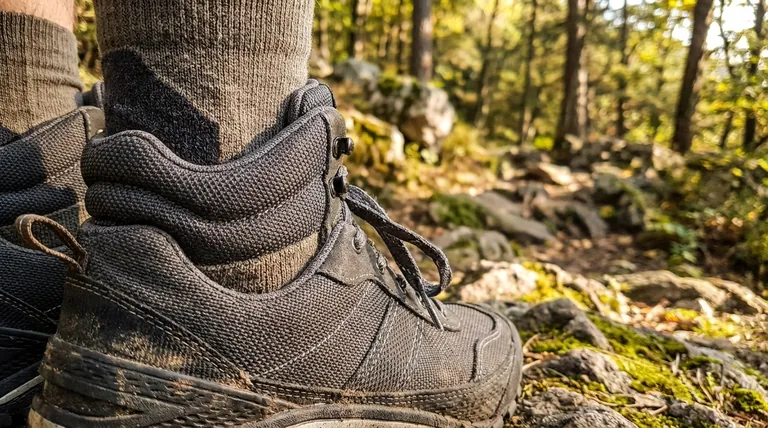In short, the collar is the padded cuff of material that wraps around the opening of your hiking shoe. It is a critical-but-often-overlooked component responsible for cushioning your ankle, ensuring a secure fit to prevent heel slippage, and protecting you from painful blisters on the trail.
The effectiveness of a hiking shoe collar is not determined by specifications on a tag, but by its feel against your unique ankle shape. It is a critical point of contact that directly dictates comfort, stability, and blister prevention.

The Role of the Shoe Collar
What is the Collar?
The collar is the uppermost part of the shoe that encircles your ankle. Think of it as the padded gateway where your foot enters and is secured within the footwear.
Its primary purpose is to create a comfortable and effective seal between your lower leg and the shoe itself.
The Core Function: Cushioning
The most immediate job of the collar is to provide soft padding for the sensitive bones of your ankle.
Without this cushioning, the stiff upper material of the shoe would dig into your ankle with every step, causing pressure points and significant discomfort.
The Key to a Secure Fit
A well-designed collar works in tandem with your laces to lock your heel into the back of the shoe.
This secure fit is essential. It prevents your foot from sliding forward on descents and your heel from lifting on ascents, which is a primary cause of friction and blisters.
Why the Right Collar Fit is Non-Negotiable
Your First Line of Defense Against Blisters
Most debilitating blisters form from repetitive friction. A poorly fitting collar—one that is too loose, too tight, or has an awkward shape—will constantly rub against your skin.
This makes the collar a make-or-break feature. A perfect fit feels like a gentle, secure hug; a bad fit will ruin your hike.
Contributing to Ankle Stability
In mid- and high-cut boots, the collar provides structural support to the ankle joint.
By bracing the ankle, a sturdy collar helps prevent twists and sprains on uneven or rocky terrain, giving you more confidence with each step.
The Necessity of an In-Person Test
Because every person's ankle shape is different, the "feel" of a collar is entirely subjective.
This is why trying on shoes in person is paramount. You must walk around, preferably on an incline ramp, to feel for any potential rubbing or pinching that could become a major issue miles down the trail.
Common Pitfalls and Trade-offs
Padding: Too Much vs. Too Little
An overly bulky collar can feel restrictive and hot, while a collar with insufficient padding will fail to protect your ankle bones from pressure and impact.
The goal is to find a balance that feels plush and protective without being cumbersome.
Collar Height: Flexibility vs. Support
The height of the collar is a defining feature of hiking footwear.
Low-cut trail shoes offer maximum ankle flexibility but minimal support. High-cut boots provide significant support and debris protection at the cost of being heavier and more restrictive. Your choice depends entirely on your needs.
Making the Right Choice for Your Hike
A shoe's collar may seem like a minor detail, but its impact on your comfort and safety is immense.
- If your primary focus is fast, lightweight hiking: A low-cut shoe with a well-padded but minimal collar offers the best blend of comfort and mobility.
- If your primary focus is backpacking with a heavy load: Prioritize a high, structured collar on a boot that provides unwavering ankle support and a secure, locked-in fit.
- If your primary focus is avoiding blisters above all else: The in-person feel of the collar is your most important metric; if you detect any rubbing or pinching in the store, do not buy the shoe.
Ultimately, paying close attention to how a shoe's collar fits your ankle is one of the most important investments you can make in your hiking experience.
Summary Table:
| Collar Feature | Primary Function | Impact on Your Hike |
|---|---|---|
| Cushioning | Pads the ankle bones | Prevents pressure points and discomfort |
| Secure Fit | Locks the heel in place | Eliminates heel slippage and friction |
| Height & Structure | Provides ankle support | Prevents twists and sprains on uneven terrain |
Don't let a poorly fitting collar ruin your next adventure. As a large-scale manufacturer, 3515 produces a comprehensive range of hiking footwear for distributors, brand owners, and bulk clients. Our production capabilities ensure every pair features a precisely engineered collar for superior comfort, stability, and blister prevention. Contact us today to discuss your hiking footwear needs and experience the 3515 difference.
Visual Guide

Related Products
- Durable Rubber Sole Outdoor Shoes Wholesale & Custom Manufacturing
- Safety Footwear Wholesale Manufacturer for Custom OEM/ODM Production
- Durable Waterproof Rain Boots | Custom Manufacturer for Wholesale & Brands
- Premium Suede Sport Safety Shoes for Wholesale & Bulk Orders
- Custom OEM Training Shoes Wholesale Manufacturer Durable & Breathable
People Also Ask
- Why are rubber-soled shoes considered multi-weather footwear? Unlock All-Season Traction & Protection
- What should be considered when choosing hiking boots for snake protection? Prioritize Fit & Materials for Safety
- How does cushioning work in hiking shoes? The Science of Shock Absorption
- What were traditional shoe soles made from before rubber? The History of Leather Soles
- What are the disadvantages of vulcanized soles? Lack of Support & Durability Explained



















